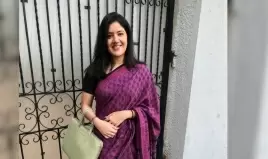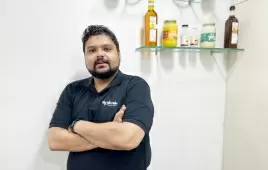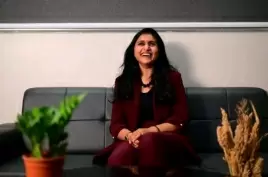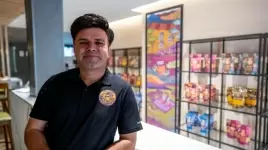A small town in Maharashtra is producing cloth for the world’s top brands

28-June-2013
Vol 4 | Issue 26
It is a small town between the ghats on the western coast of India. Located about 425 kilometres south of Kolhapur in the state of Maharashtra, few would have heard of Ichalkaranji, and fewer still would have visited it.
Those who live there – generally of modest means and who number around three lakh – proudly refer to it as the ‘Manchester of India’, although they themselves may not know where or what Manchester is.
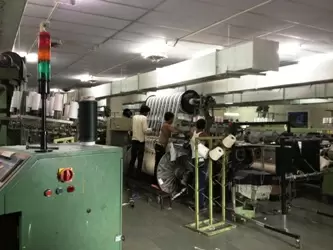 |
|
Ichalkaranji produces cloth not just for the domestic market but also for Italian and French companies (Photos: Sudhamahi RegunathanWFS)
|
Ichalkaranji is a town of contrasts. While the people here are for the most part poor workers who eke out a living in textile mills, it is also the home of the super rich and notches one of the highest per capita incomes in India.
In fact, Ichalkaranji could be deemed as one of India’s premier textile hubs – producing cloth not just for domestic markets but for Italian and French companies.
The sugar industry and the barons who control it are also located in this region through which criss-crosses the River Panchganga.
Today, the cloth produced by Ichalkaranji is woven on power looms. As part of a princely state it had come under the administration of Shrimant Narayanrao Babasaheb Ghorpade.
People say it was Ghorpade who was instrumental in setting up a power loom here – possibly the first of its kind in India. But even earlier to this, weaving must have been something of a tradition in this town because the term ‘ichalkaranji’ recalls the terminology used for weft threads.
Until recently, the town’s main products were ‘dhotis’ and saris, not to mention thicker materials such as sheets and textiles for garments.
Nowadays, the industry caters to foreign markets and has moved from largely weaving cotton textiles to spinning polyester mixed material, viscose, spandex, and so on – materials used by the most fashionable of international designers.
Huge spindles of raw yarn lie in the outer room of one of the textile mills I visited.
Explained Mahesh, one of the floor managers, “This raw yarn is wound around a large spindle in accordance with the colour and design of the end product. This is the warp of the textile.
“The weft consists of bundles of thread that are positioned on bobbins and which flit in and out of the warp to create the desired design. Since the entire raw material has been bought by the buyer, the finished product is unique and in accordance with the design given by them.”
To the layperson the enormous piles of fabric lying on the floor would seem ready for the wearer, but Mahesh pointed out that it was not finished fabric. “The cloth has to go through many processes before it can be used to make a garment,” he said as he escorted me to an adjoining building where a small unit carried out the finishing processes.
“Most of our commissioned fabric is not finished here – it is sent to different places such as Bhilwara and Nasik for that. Here we do the finishing for ‘dhotis’, saris and plain cotton fabric. Even this is a commissioned job,” said Mahesh.
The global textile industry, a buyer-driven network, is dominated by retailers, marketers and manufacturers.
In the newly defined business environment for textiles, retailers like Hugo Boss, Gap, H&M, and others, have redefined fashion trends, which can be as short as two months. Their colour schemes and designs are often made and even replicated by smaller manufacturers.
In the processing unit for saris and ‘dhotis’ that I visited the cloth was being bleached, starched and then passed through a hot press to dry. A huge boiler was placed at the entrance of the processing unit that supplied the heat within. Until this point all the activity was being done by the men.
From there on, if the fabric has to go as yardage it is loaded on to trolleys, awaiting packaging. If, however, it has to be made into ‘dhotis’ or towels they need to be cut into the right sizes – a task that is done predominantly by women.
“We get the job when the men are not available. If the men are free, our employers prefer them because they are faster,” revealed Meenakshi, a local textile worker.
The women here work in pairs. While one holds the edge, the other runs a pair of scissors across the breadth of the fabric. Each time such a cut is made, they get paid 40-50 paise.
“We usually manage to cut 600-700 pieces every day,” said Meenakshi. Her partner – who turned out to be her mother-in-law – clarified, “That count is valid if it is thin towels we are doing. If it is thicker cloth, it takes longer and we cut fewer pieces.”
The payment though remains the same. She also emphasised that workers have to come in pairs otherwise they do not get the job.
Most women are employed at this stage only as prior to this the work is too labour-intensive and involves excessive exposure to heat. But although most of the units are run by men, some like the Kallappanna Awade Ichalkaranji Sahakari Cooperative is providing financial support for women’s Self Help Groups.
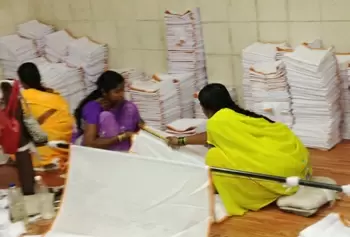 |
|
Women workers at a factory
|
Aware of the rather perilous status of the textile industry, the government has tried to provide support.
Said Shailaja, one of the few women entreprenuers to have entered the field, having set up a textile unit recently, “There are many incentives. We get tax subsidies from the government and can also avail of training programmes, but support for women entrepreneurs is still slow in coming. The risk is in getting the first order. Once that is obtained, the rest follows in line. But all this is not easy for a woman.”
In the 2011-12 budget the then Finance Minister Pranab Mukherjee had allotted Rs 70 crore for the power looms in this town.
“Inchalkaranji is progressing fast. The textile industry of India operates largely in the form of clusters – with roughly 70 textile clusters producing 80 per cent of the country’s total textiles,” said Prakash Awade, a former minister of textiles in the Maharshtra government.
He is also on the verge of setting up a cluster for garment production that will be for women entrepreneurs.
Garments fetch a higher price than textiles. As the trend to buy readymade garments grows, the textile giants of Ichalkaranji are looking to expand into the garment sector.
If that happens, Ichalkaranji will reap even greater profits, a development that will change its face forever. -Women's Feature Service


